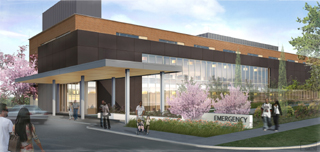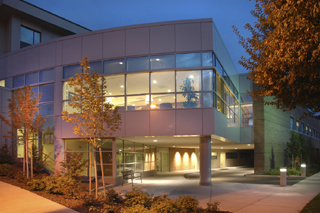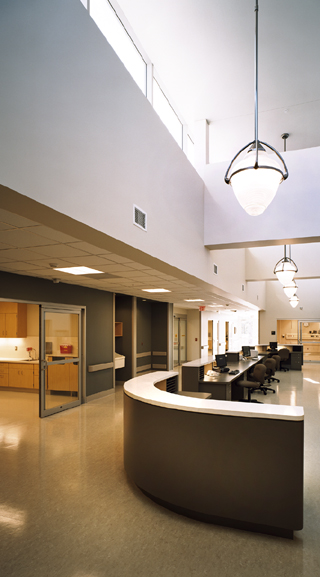
DJC.COM
April 23, 2009
Rural hospitals can build wisely if they have a plan
Mahlum

Lober
|
Community hospitals throughout the region face major challenges: an aging or obsolete physical plant, staff shortages and limited budgets for facility improvements.
The challenges are particularly acute during the current economic crisis as health providers face diminishing reimbursements, reduced patient visits and limited access to credit. As a result, there is enormous pressure to cancel all physical plant expenditures. Now more than ever, hospitals need to carefully evaluate every capital dollar spent — and that requires a well-considered plan.
Although help is available to small rural hospitals in the form of special financing under federal programs, hospitals in communities that are too large for federal help but not of sufficient size to attract urban-oriented medical staff have no such financial support. It remains to be seen how much medical stimulus money will benefit hospitals with no"shovel-ready" projects.
Have a plan

Image by Studio 216, courtesy of Mahlum Enumclaw Regional Hospital will provide community meeting and event space when it opens in 2010. |
Most rural hospitals in Alaska, Oregon and Washington are at least 40 years old, which usually means they have asbestos, poor ventilation, small patient rooms, inadequate infrastructure, and inefficient mechanical and electrical systems. Built at a time when hospitals were focused on inpatient care, the structures often pose challenges to hospital staff trying to shift more toward outpatient care.
Hospitals in towns with declining economies may have no option but to maintain status as "critical-access" hospitals indefinitely, to limp along with aging facilities, or to close. For others, there is hope — if they follow the example of hospitals that have faced the challenges successfully.
Despite the temptation to cancel all capital planning, particularly now because of the uncertain economy, it is imperative that community hospitals, regardless of size, have a master plan to guide capital expenditures for at least a five- to 10-year horizon. It is unwise and financially risky to embark on a quick project to expand one part of a facility — for example, the emergency department or diagnostics — without knowing how that addition might fit in with the rest of the hospital in five or eight years.
Changes in stages
Some years ago, St. Mary Medical Center in Walla Walla undertook a master planning process that enabled it to transform, in stages, the 1970s-vintage inpatient-focused facility to a more friendly outpatient center with beds. The planning identified a series of projects that could be implemented over time in phases as funding became available.
The first addition provided for a new front-door admitting area, emergency department, pharmacy and radiology unit. The second phase called for a cancer center, and the final phase a new outpatient surgery facility.
The forward-looking master plan provided for the same operating room to be used by both inpatients and outpatients, separate entrances for the new additions, and a "wraparound" look to give the facility a more contemporary, cohesive look.
A similar approach was taken by the Southeast Alaska Regional Health Consortium in Sitka, Alaska. Prior to renovating Mt. Edgecumbe Hospital, the consortium did a thorough assessment of its 17 buildings and a long-range master plan for a series of projects that were carried out over 10 years. In so doing, it avoided problems other hospitals have encountered when they quickly build an addition or undertake a renovation only to discover it incompatible with other improvements added only a couple of years later.

Photos by Jim Van Gundy Photography
An outpatient addition at St. Mary's Hospital in Walla Walla surrounds an older part of the hospital to create an updated look. This was one of a series of projects built as funding became available. |
A relevant master plan should enable even the smallest community hospital to provide for the basic core services — 24-hour emergency services, diagnostic and radiological services, inpatient beds — while offering services unique to its location or community.
For example, a hospital in Ketchikan, Alaska, has greater emergency department needs during the summer tourist season. Other communities may need to focus on long-term care so that elderly residents can stay close to home.
Because capital is so stretched, community hospitals require, above all, flexibility in how their facilities are designed. Departmental adjacencies are critical so that patients can be moved easily from one treatment area to another. Rooms need to be large enough to accommodate different kinds of treatment, and the facilities need to work efficiently with fewer caregivers providing more care.
Retaining staff

The emergency room at St. Mary's admits natural light into a work area to make the environment more pleasant for staff. Such amenities are important for employee recruitment and retention, particularly in rural areas. |
Because community hospital staff are limited in numbers, planning needs to accommodate measures that help attract and retain staff. The somewhat remote location of some hospitals makes it difficult to recruit new staff, so hospitals need increasingly to provide a pleasant work environment. Healing gardens, like the one at Providence Newberg in Oregon, are as much a boon to hospital staff as they are to patients and their families.
With the increased demand on staff, they need places to decompress, places that offer privacy and that have ample natural light and views to the outside. The replacement hospital in Nome, Alaska, includes workout facilities for staff and exterior windows in all the staff break rooms.
In a small community like Nome, hospitals often are the center of the community, not only in normal times but during emergencies. St. Mary's Medical Center has two classrooms that are used for public meetings and staff training. One hospital in Enumclaw was the only place in town where people could get hot meals during a major power outage because it had an emergency generator.
Looking ahead, community hospitals face even more challenges from aging baby boomers. That means a need for more universal rooms, more intensive-care equipment, and facilities that can accommodate patients who come later and stay longer.
Faced with these challenges, hospitals will be looking at more shared physicians — specialists from a larger city who may spend a day a week at a community hospital — or telemedicine, where patients can be diagnosed and possibly even treated long distance.
Hospitals with a master plan ready to go will be properly poised to make smart expenditures and reinforce their market position once the economic crisis passes and before inflation returns.
Robert Lober is a partner with Mahlum Architects, which has offices in Seattle and Portland. He is director of the Seattle studio that specializes in health care and technology.
Other Stories:
- New health care construction: Always costly, rarely needed
- When electronic systems 'talk,' patients, hospitals benefit
- Hospital project prices falling, but it is still buyer beware
- Architects: Listen and learn from your clients
- Designing to get the most bang for your buck
- New air system could keep patients warmer and healthier
- Lean design cuts cost for Covington medical building
Copyright ©2009 Seattle Daily Journal and DJC.COM.
Comments? Questions? Contact us.